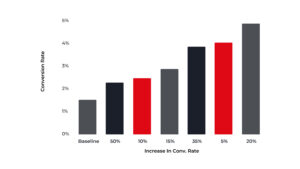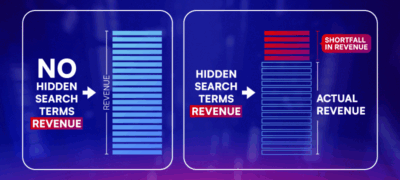
CRO and Landing Pages Are No Longer Optional
It’s no secret that businesses advertising online are being squeezed between rising ad costs and increasing competition. Scaling profitably has never…
It’s no secret that businesses advertising online are being squeezed between rising ad costs and increasing competition. Scaling profitably has never been harder. The competition is making more and more effective ads. The amount of ads being tested has increased drastically. The ads arms race has reached a fever pitch. The result? Less meat to scrape off the bone with ad optimizations.
 Fortunately, there are other, largely untapped, ways to increase returns when advertising online. Conversion rate optimization (CRO) is one such method. Larger brands have been utilizing CRO for some time. It’s now becoming economical for smaller and smaller businesses to follow suit. While there are still many smaller brands that don’t do CRO and whose user experience (UX) is horrific yet somehow remain profitable in acquiring customers online, this will not last much longer. The clock is ticking for businesses that run the same landing page for years.
Fortunately, there are other, largely untapped, ways to increase returns when advertising online. Conversion rate optimization (CRO) is one such method. Larger brands have been utilizing CRO for some time. It’s now becoming economical for smaller and smaller businesses to follow suit. While there are still many smaller brands that don’t do CRO and whose user experience (UX) is horrific yet somehow remain profitable in acquiring customers online, this will not last much longer. The clock is ticking for businesses that run the same landing page for years.
For the majority of small businesses advertising online, starting a CRO program is almost guaranteed to yield better results than doubling down on just ad optimization.
Let’s say a brand does 10k/mo in creative testing. They’ve been testing creatives for months. Initially, they had some big wins and as time goes on there are still wins but the lift provided by the latest creative wins isn’t as significant as before. Once thrown in the mix, these creatives will reduce the overall CPA by some amount. Of course with CPMs fluctuating and ads sharing and competing for budget, it’s impossible to tell for sure the impact made.
In contrast, a lot of low-hanging fruit is typically immediately available when starting a CRO program. By developing a hypothesis or even hypotheses for a series of changes for a new version of the landing page, and running that new page as a test, it’s not at all unrealistic to increase a conversion rate by 50%. For example, an increase from a 3% conversion rate to 4.5%. Results vary but for the sake of simplicity, it’s reasonable to expect 5x to 10x more improvement in marketing efficiency right off the bat when starting a CRO program compared to just running a mature creative testing program.
Of course, the increases in advertising efficiency will start to diminish over time, in the same way they do with ad creative testing. That said, there is so much room for easier and faster improvements via implementing a CRO program compared to dumping more and more money into just ad creative testing alone. Big brands know this. That’s why they have a head of CRO, UX experts, full-time landing page developers, etc. For brands spending 5 figures a month to lower 6 figures a month in ad spend who have not professionally implemented a CRO program, this is likely the surest way to net the highest return on any investment that they could make.
Why do LPs and CRO in general work in the first place?
Landing pages tend to work better than product pages, especially for sites that don’t have a huge product selection, because they focus people toward one objective. The golden rule of running landing pages is to have a single CTA that you drive people to. Product pages often have a lot going on and the ability to navigate to potentially dozens of other pages from there. People get lost on the website and end up bouncing. Ideally, all of the information that people would search for or need to be able to convert should be easily findable on the LP itself. This streamlines the process, keeps people in one place, improves their experience, and ultimately increases the conversion rate.
While a first-iteration LP will typically perform better than a product page, the true power of LPs is in the cumulative increase of the conversion rate over time with each iteration.
 Things in digital marketing are never static. Things either slowly or very quickly degrade over time as costs and competition increase. Running a CRO program more than compensates for this downward trend. Those who don’t run one aren’t staying in place, they’re slowly slipping and losing little by little with each month that passes.
Things in digital marketing are never static. Things either slowly or very quickly degrade over time as costs and competition increase. Running a CRO program more than compensates for this downward trend. Those who don’t run one aren’t staying in place, they’re slowly slipping and losing little by little with each month that passes.
Why Ad Agencies Are Uniquely Positioned To Run CRO Programs
Given the choice between creating an in-house CRO team at great expense and risk (especially if no one in the company is a CRO expert!), it typically makes sense for non-enterprise clients to have their agency partner run their CRO program. There are some big bonuses to this if that agency is also running their ads.
Ad agencies are intimately familiar with the audience, the messaging, and the positioning of their clients. This allows them to take big shortcuts when planning landing pages. Without this background knowledge, a lot of time is required to get up to speed with what has tended to resonate with the audiences across digital marketing channels.
In addition to being familiar with the audience, when ad agencies do LPs for clients they can better align the pages with the ads. This creates a more coherent and seamless experience for potential clients moving through the buyer’s journey.
This applies to learnings as well. Once something has been proven to perform better either in the ads or the LPs, those learnings can be transferred between each of them for faster optimization of both the ads and the LPs.
Final Thoughts
As the digital marketing bar keeps getting raised, there are big opportunities for those who seize the initiative. CRO is now a cornerstone of successful digital marketing. Those who are ahead of the curve are eating everyone else’s lunch. In the early days of Facebook Ads, there were businesses built on running one super low effort and bad quality ad for years. As the competition increased this no longer became viable in the same way that static businesses will soon simply no longer be able to compete with others running CRO programs.
In short, we encourage brands that we work with to invest in CRO as the return on that investment will very quickly justify the effort. Additionally, we encourage brands that we don’t work with to stay far away from CRO so that our clients can take a bigger slice of the pie.
Related Articles

- PPC
The High Cost of Hidden Search Terms: How Google Skims Profit from Advertisers
Google claims that search terms are hidden for privacy reasons and not performance reasons, so we wanted to find out: Do…

- Paid Social
Found a Winning Ad? Here’s How to Iterate on It Properly
Let’s say you’ve finally cracked it. You launched a new concept, and it’s outperforming everything else in your account. ROAS is…

- Paid Social
5 Learnings From Auditing Dozens of Meta Ad Accounts
At Taikun, we’ve audited dozens of Meta ad accounts in the past few months. The brands varied, but the patterns were…
How can we help you grow?



